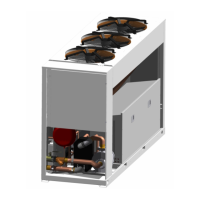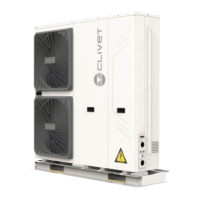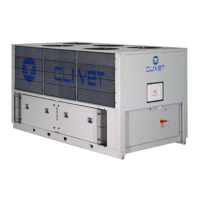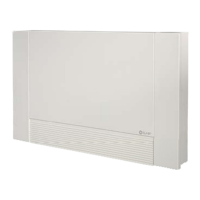42
®
Control
ANTIFREEZE PRE-ALARM THERMOREGULATOR
The antifreeze pre-alarm function is active in all operating modes.
The purpose of the function is to prevent the evaporator outlet water temperature from falling too low, and thus causing the unit to
shut-down due to the antifreeze alarm. The function acts as follows: if the evaporator outlet temperature is less than or equal to the
pre-alarm threshold, one compressor capacity-control step is deactivated, according to the compressor rotation requirements. If the
temperature is still lower than the pre-alarm threshold, a further capacity-control step is deactivated.
The same compressors or steps can only be reactivated by the thermoregulator if the outlet temperature has risen over the threshold
by a value set in the factory.
HIGH PRESSURE ALARM PREVENTION
For the purpose of preventing the unit from shutting down due to a high pressure alarm, a function has been implemented to avoid this
phenomenon. The thermoregulator, using the pressure transducers, continuously controls the condensing pressures; when the
controlled value exceeds a pre-set threshold, the thermoregulator forces the fans to maximum speed, so as to lower the condensing
pressures. If this action is not sufficient and the pressure continues to rise, when exceeding another threshold, the thermoregulator, as
well as forcing the fans to maximum speed, also switches off one of the tandem compressors.
FLUID THERMOREGULATOR
The thermoregulator operates so as to maintain the temperature of the fluid at the plate exchanger outlet as near as possible to the
SET POINT (COOLING/HEATING) value.
The thermoregulator can activate one and only one step at a time, and only after the activation scan time has expired. No steps can
be activated at any other time. The activation scan time is not fixed, but rather varies according to the difference between the water
outlet temperature and the current set point value.
The higher the temperature difference (either positive or negative), the shorter the interval between the scan points.
The water outlet probe is used in this case.
IN COOLING MODE
The thermoregulator will tend to deactivate capacity-control steps when the outlet water temperature falls below the Current Set Point
value.
Vice-versa, it will tend to activate capacity-control steps when the outlet temperature exceeds the sum of Current Set Point and the
theoretical temperature difference between the water inlet and outlet due to one single capacity-control step.
IN HEATING MODE
The thermoregulator will tend to deactivate capacity-control steps when the outlet water temperature rises above the Current Set Point
value.
Vice-versa, it will tend to activate capacity-control steps when the outlet temperature falls below the sum of Current Set Point and the
theoretical temperature difference between the water inlet and outlet due to one single capacity-control step.
CIRCULATING PUMP MANAGEMENT
When the unit is started, or switched to remote ON, the pump is started first, and the operation of the compressor is enabled only after
the scan time. The flow alarms are ignored for the first 20 seconds from when the pump starts. In this way, the pump has time to reach
stable fluid flow conditions, thus avoiding the formation of bubbles. In the event where the unit is switched off remotely, the
compressor and the fans will stop, while the pump stays on for 120 seconds.
COIL FAN CONTROLLER
The controller operates so as to maintain the condensing/evaporation temperature as constant as possible upon changes in the unit's
operating conditions, by suitably varying the operation of the fans: in summer operation, the speed increases as the outside air
temperature increases, and vice-versa in winter operation.
COMPRESSOR ROTATION
As well as the optimum control of the fluid temperature, the processor also controls other functions for the correct management of the
overall operation of the unit. This is the case, for example, of compressor rotation. The compressor
rotation function is enabled by setting the corresponding parameters. The thermoregulator then compares the operating hours and
starts of each compressor.
Each parameter is weighted (for example: operating hours 70%, compressor starts 30%). This means that when the thermoregulator
calls the operation of a compressor, the first compressor that starts will be the one that, considering the starts and number of
operating hours, has worked less. This function avoids having compressors with significant differences in the amount of wear. The unit
is supplied by the manufacturer with rotation enabled.
FLOW ALARM MANAGEMENT
The flow alarm refers to the shut down of the unit due to the activation of one of the devices present in the line of flow; differential
pressure switch, flow switch.
The operating logic of this alarm is summarised as follows:
a) If the pump is off, the flow alarm is not detected (the compressor cannot operate in any case).
b) For a few seconds from the start of the pump, the flow alarm is not detected, thus allowing the pump time to bring the system to
stable operating conditions.
c) When the remote OFF command is received, the flow alarm is disabled.
d) If a flow control device is activated, when reset, the corresponding contact must stay closed continuously for around 5 sec. for the
alarm to be reset.

